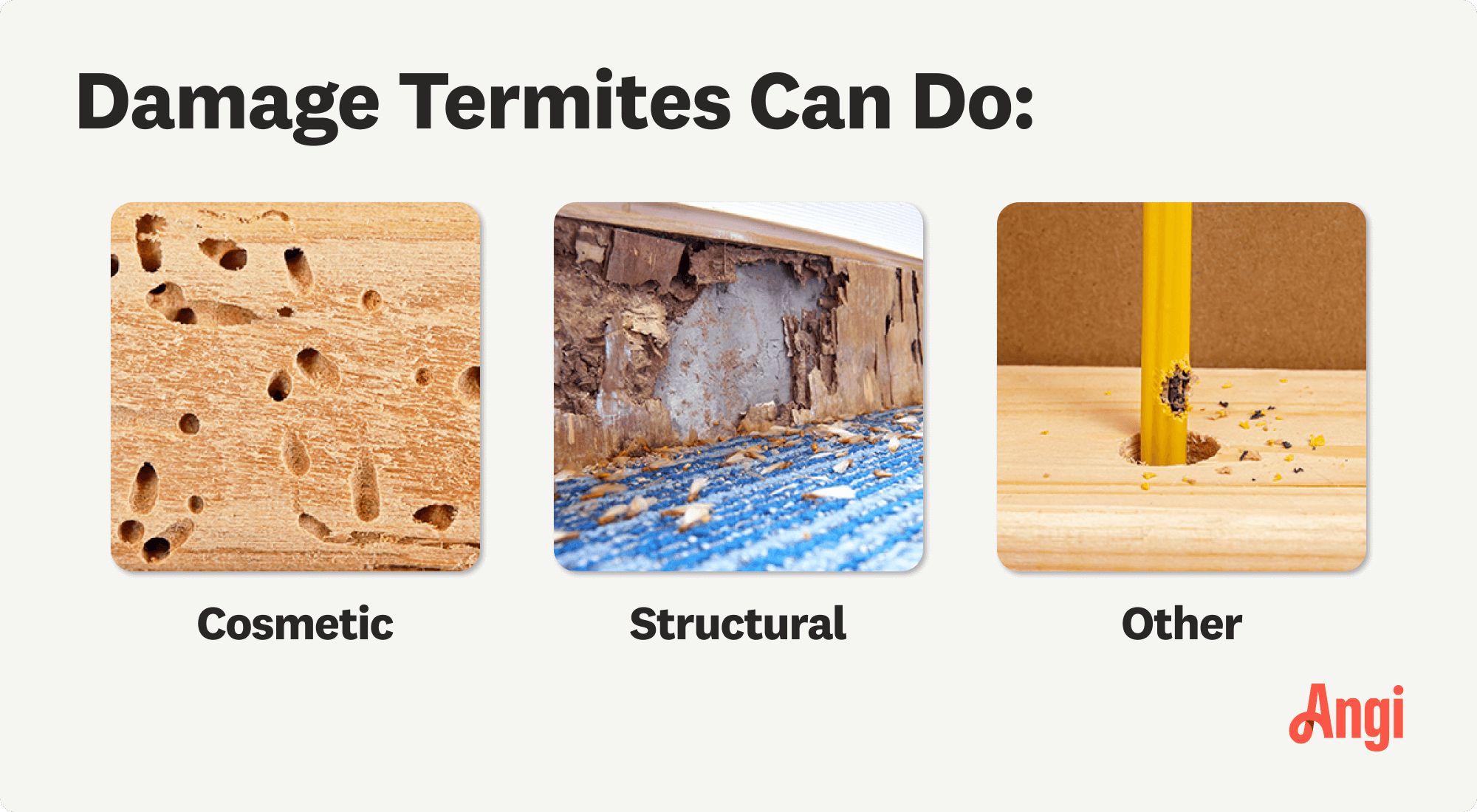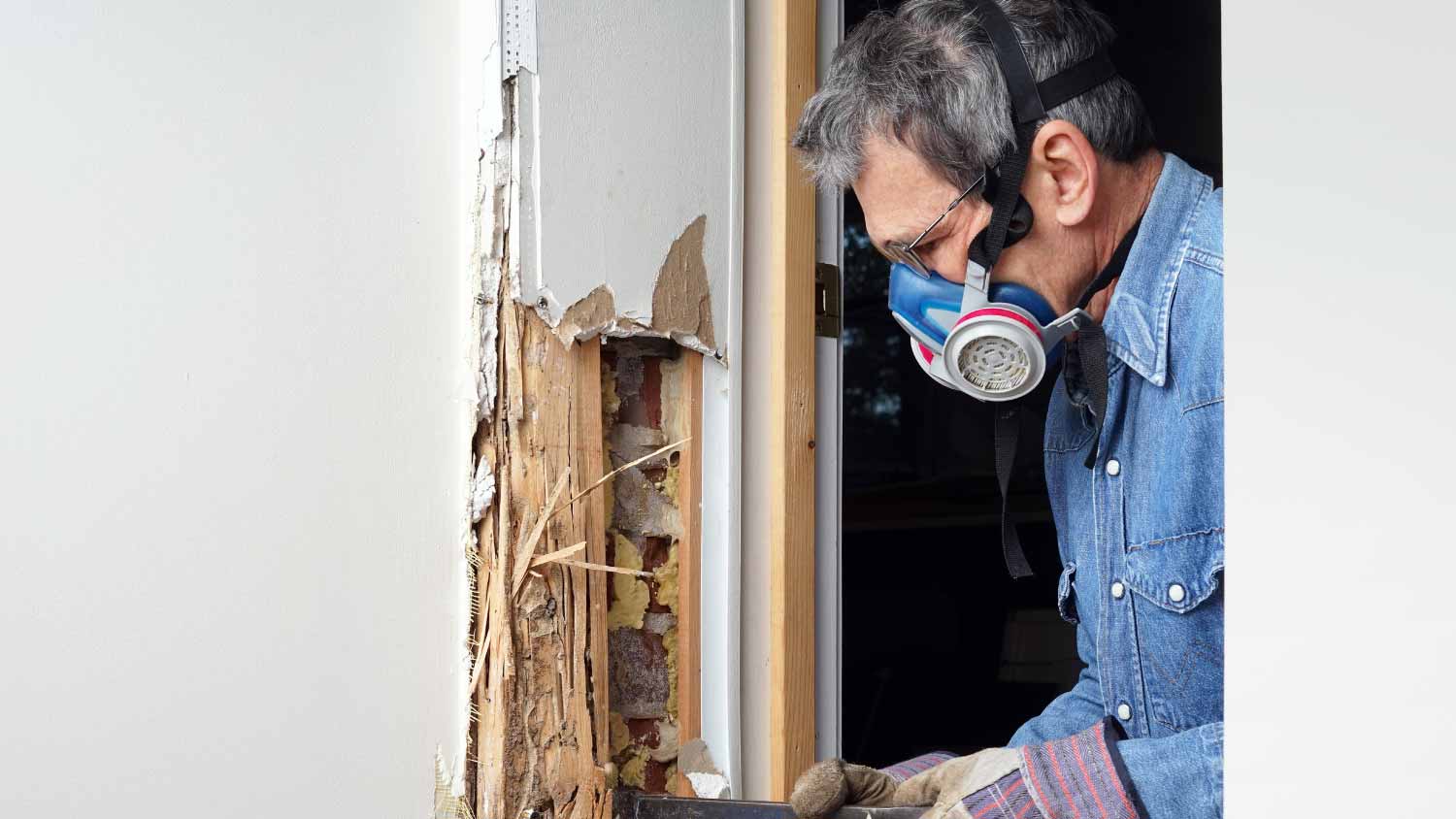
How much does a gnat exterminator cost? The answer depends on the method of treatment and the level of infestation. Find out what plays into your budget.
Look for signs of termites before they cause too much damage to your home


Termites can cause a lot of damage to your home.
They may be visible in swarms or leave behind wings.
Subterranean and drywood termites may dig tunnels in wood.
Dampwood termites can be found in wet or rotting wood.
Termites spread quickly, so call a pro to inspect your home at the first sign of termites.
When you watch enough home improvement shows, you learn to live in fear of the dreaded termite. But by watching for the warning signs of termite infestation, you can catch them before they cause too much damage in your home. From mud tubes to blistering walls, termite evidence can be elusive, but this guide will help you know what signs to keep in your sights.
Termite infestations can be difficult to detect, so keep an eye out for changes in your wood features, such as floors bubbling or deck sagging. Don't hesitate to take pest control action to prevent the infestation from growing.

No matter which sign tips you off to an infestation, it’s best to handle termites as soon as possible. If you think you might have an infestation, check for these warning signs of termites and contact a termite control company near you for a professional termite inspection.
Subterranean termites will create tunnels of mud (called mud tubes) or even their own saliva and feces. You might notice these tunnels in foam insulation, the drywall, or around your home, starting toward the ground and moving up. Tiny holes in drywall are also a sign of tunneling.
Although they tend to stay underground when they aren’t searching for food, you still may see swarms of subterranean termites. These swarmers have two sets of large, pale wings. The swarmers in a colony are responsible for reproduction.
After reproducing, the swarmers shed their wings. As such, you may notice discarded, pale wings that are about ¼ to ½ inch long around bright areas, like doors and windows.
Once they find a good food source, drywood termites make that spot home. As such, they leave tunnels in maze-like patterns in the wood surfaces of your home. You may notice patterns of tunnels in wood walls, floors, or furniture if you have a drywood termite infestation.
Since they eat and nest in the same area, drywood termites also defecate in this location. That means you’ll find termite feces around the site of the infestation. Drywood termite droppings look like tiny little pellets. You may find termite feces around floors, baseboards, window sills, furniture, or walls and ceilings.
If drywood termites are eating away at the wood in your walls, floors, or ceilings, it can cause these surfaces to shift and sag. You may notice squeaky floorboards, peeling paint, or bubbling water damage in walls when drywood termites are eating away at these surfaces.
Termites feed across the wood grain. If you knock on the wood portions of your home and it sounds hollow, you may have a termite problem. Any visible wood damage, such as crumbling spots, is a clear sign of termite activity. And if you have exceptionally squeaky floors, it could mean there’s damage to the supporting wood boards beneath it.
Dampwood termites thrive in damp or rotting wood. If you notice soft or squishy wood, you may have water damage—or water damage and termites. A roof leak or leaky pipe can cause damage to your floors and cabinets, and attract these pests.
If you see termites outside, either crawling or swarming, especially if it’s close to your foundation, it’s a clear sign of a termite infestation. If you have rotting stumps or other decaying wood on your property, it's important to inspect them closely for termites, too. A mass of small, white ant-like insects could be termites, and if they're in close proximity to your home, there's a possibility they may have infiltrated your walls and other wooden structures.
Carvings that resemble the marks made by knives and rough troughs (mud tubes) could indicate early stages of termite damage. It's worth noting that galleries made by carpenter ants, another type of wood-destroying pest, will have a smooth texture.
If your home is infested with termites, it's possible to hear noises coming from the affected area. This sound is like a faint clicking noise, which results from soldier termites banging their heads against the walls to signal danger.
Termites often begin by targeting easily accessible areas like windows or door frames. As the insects eat through the wood, they lose their support, and you may notice that opening or closing the windows and doors becomes more difficult.

There are actually three types of termites: drywood, subterranean, and dampwood termites. Each of these three types of termites can cause damage to your home, and have slightly different warning signs.
As their name suggests, subterranean termites nest underground. They typically only come to the surface for feeding. Some clear signs of subterranean termites include:
Tunnels
Swarms
Wings
Drywood termites are most likely found in homes located in warm climates, like the southern U.S. These termites nest in dry wood sources, and signs of these pests include:
Mazes
Termite droppings
Sagging walls, floors or ceilings

Opposite to drywood termites, dampwood termites prefer wet or rotting wood. Although larger than other common types of termites, they have smaller colonies. Dampwood termites can usually remain undetected for long periods of time until a termite inspection, and are mostly found in the Western U.S. Some signs of dampwood termites include:
Hollow wood
Soft wood
Swarms
There are various DIY treatments for removing termites, such as bait, diatomaceous earth powder, liquid termiticide, and more. However, working with chemicals can be hazardous and may not be as effective as a trained pest specialist. When you hire a local termite control professional, you can rest easy knowing that the job will get done right and that they can help prevent future infestations. You will need to hire a termite removal professional to eliminate major infestations because it requires highly specialized processes like termite tenting.
Prevention is better than having to deal with termite infestations. Try these key tips for preventing termites before they start making a snack out of your home:
Minimize moisture: Termites and other pests thrive in moist areas. Fix any leaks and close any gaps where water can get into the home. Eliminate standing water near the house's foundation, and consider using a dehumidifier in damp basements and crawl spaces.
Eliminate food sources: Since termites feed on wood, you should keep lumber, firewood, and any wood materials away from your home. Clearing away dead trees and stumps can also help prevent them from heading toward your house.
Maintain your lawn: Keep bushes trimmed away from your home, and cut the grass regularly. This method can help prevent termites from feasting on things in your yard and working their way into your house.
Schedule regular termite inspections: In addition to checking for signs of termites yourself, you should consider hiring a professional to perform regular termite inspections. The average price of an inspection is $165, but can range between $75 and $200.
The national average cost to treat termites is $620, but it can range from $75 to $1,730. The cost of having a professional treat your home for termites depends on several factors, such as the type of treatment, the size of the infestation, the area of the infestation, and your location. You can expect to spend about $230 to $970 per treatment. Professionals will be able to identify the type of termites and get a better idea of the size of the infestation. You may need multiple treatment sessions to fully eradicate a colony of termites.
However, hiring a pest control specialist is much more affordable than the severe damage termites can do to your home. The average cost to repair termite damage ranges from $1,000 to $10,000! So, if you have warning signs of termites, take action as fast as possible to save money in the long run.
Termite damage affects building exteriors in 36.6% of cases, followed by wood framing, trim, and furniture. While less common for pest control visits, your attic, garage, and yard aren’t immune to termite infestations.
From average costs to expert advice, get all the answers you need to get your job done.

How much does a gnat exterminator cost? The answer depends on the method of treatment and the level of infestation. Find out what plays into your budget.

Find out how much it costs to remove armadillos and stop them from coming back. Know how much to budget to humanely remove these pesky critters from your yard.

Bats may have their benefits, but you don't want them taking up residence in your home. This guide will help you understand bat removal costs.

Water bugs are pesky creatures that may enter your home in search of water and food. Learn how to prevent water bugs from entering your home.

If you’re a fan of essential oils, some believe you can use them to deter pests like spiders, mice, and other rodents. Learn more about how you may be able to use essential oils like to help leave your home pest-free and smelling great.

Whether it’s a swarm of mosquitos interrupting your summer evening on the patio or the discovery of fleas in the guest room, you may have to break out bug spray. Read on for tips to reduce your exposure and signs of bug spray side effects.